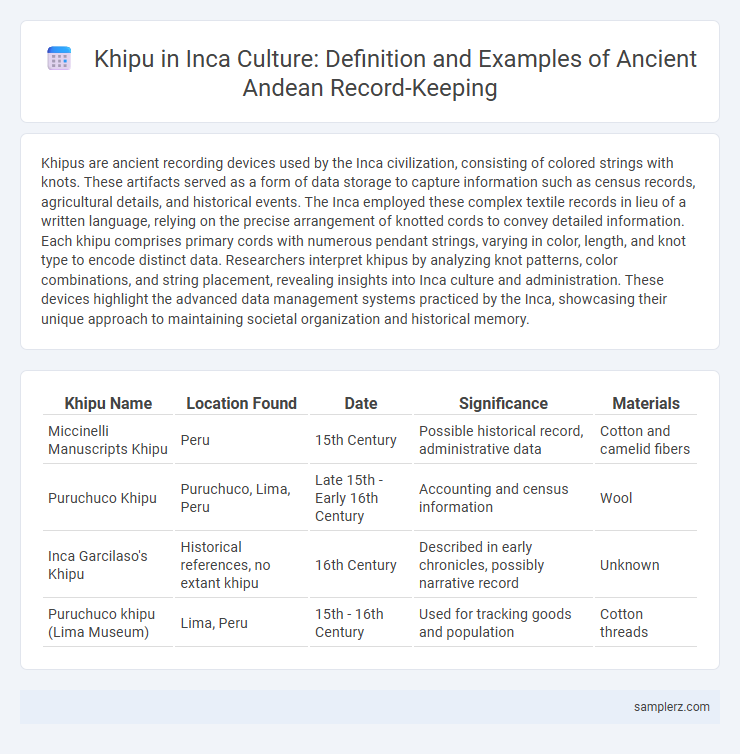Khipus are ancient recording devices used by the Inca civilization, consisting of colored strings with knots. These artifacts served as a form of data storage to capture information such as census records, agricultural details, and historical events. The Inca employed these complex textile records in lieu of a written language, relying on the precise arrangement of knotted cords to convey detailed information. Each khipu comprises primary cords with numerous pendant strings, varying in color, length, and knot type to encode distinct data. Researchers interpret khipus by analyzing knot patterns, color combinations, and string placement, revealing insights into Inca culture and administration. These devices highlight the advanced data management systems practiced by the Inca, showcasing their unique approach to maintaining societal organization and historical memory.
Table of Comparison
| Khipu Name | Location Found | Date | Significance | Materials |
|---|---|---|---|---|
| Miccinelli Manuscripts Khipu | Peru | 15th Century | Possible historical record, administrative data | Cotton and camelid fibers |
| Puruchuco Khipu | Puruchuco, Lima, Peru | Late 15th - Early 16th Century | Accounting and census information | Wool |
| Inca Garcilaso's Khipu | Historical references, no extant khipu | 16th Century | Described in early chronicles, possibly narrative record | Unknown |
| Puruchuco khipu (Lima Museum) | Lima, Peru | 15th - 16th Century | Used for tracking goods and population | Cotton threads |
Introduction to Khipu: The Inca Knotted Records
Khipu, an ancient Inca recording system, used knotted cords to encode information, enabling the administration of the vast Inca Empire. These intricately tied knots represented numerical data and potentially narratives, serving as a highly sophisticated communication tool without written language. Archaeological discoveries of khipus reveal their crucial role in accounting, census-taking, and historical record-keeping, showcasing the Inca's advanced knowledge in information management.
Historical Context: Khipu in Inca Civilization
Khipu, an ancient Inca system of knotted cords, served as a vital tool for recording numerical data and administrative information in the vast Inca Empire during the 15th and 16th centuries. These textile records enabled state officials to manage resources, census data, and tribute obligations across diverse regions without a written language. Archaeological findings of khipu artifacts in sites such as Machu Picchu and Cusco highlight their significance in preserving Inca historical and cultural legacy.
Structure and Materials of Khipu
The khipu, an ancient Inca recording device, consists of a primary cord from which numerous pendant cords hang, each tied with specific knots representing numerical and linguistic data. Made primarily from cotton or camelid fibers such as alpaca and llama wool, the cords are dyed in various colors to convey additional information through a complex color-coding system. The combination of knot types, cord structure, and material composition allowed the Inca to maintain detailed records of census, resources, and historical events without a written language.
Decoding Khipu: Methods and Theories
Decoding khipu involves analyzing intricate knotted cords used by the Inca for record-keeping and communication, relying on variations in knot types, placement, and color to convey numerical and narrative information. Researchers employ statistical methods, computer modeling, and ethnographic comparisons to interpret these coded messages, uncovering insights into Inca administration and social organization. Theories suggest khipu functioned as an ancient binary system, linking numerical data with mnemonic storytelling that challenges conventional writing paradigms.
Example 1: The Caral Khipu
The Caral Khipu, discovered in Peru's ancient city of Caral, represents one of the earliest known examples of khipu, dating back to around 2600 BCE. This complex system of knotted cords served as a mnemonic device used by the Inca civilization for record-keeping and communication. Researchers emphasize its significance in understanding pre-Columbian Andean cultures and the development of non-written record management systems.
Example 2: Khipu from Puruchuco
The Khipu from Puruchuco exemplifies the Inca's sophisticated record-keeping system, featuring a series of knotted strings used for accounting and communication. This particular artifact reveals complex numerical data encoded through varied knot types, lengths, and colors, demonstrating the Inca's intricate administrative capabilities. Archaeological studies highlight its role in managing agricultural production and labor organization within the Puruchuco region near Lima, Peru.
Example 3: Chachapoyas Khipu Discoveries
Chachapoyas khipu discoveries reveal a unique variation of the traditional Inca quipu system, characterized by complex knot patterns and distinctive color usage. Archaeological findings suggest these khipus played a vital role in record-keeping and communication among the Chachapoya people, integrating local practices with Andean cultural elements. Detailed analysis of these artifacts provides valuable insights into the socio-political organization and information management within the Chachapoyas region.
Cultural Significance of Khipu in Inca Society
Khipu, an intricate system of knotted cords, served as a vital tool for record-keeping, communication, and administration in Inca society. This unique method encoded numerical and possibly narrative information, reflecting the sophisticated organizational structure of the empire. Beyond practical uses, khipus held cultural significance as symbols of authority and spiritual connection, linking the Inca people to their history and cosmology.
Modern Research and Conservation of Khipu
Modern research on Khipu focuses on advanced techniques like digital imaging and 3D modeling to decode the complex knot systems used by the Inca civilization for record-keeping. Conservation efforts emphasize the preservation of fragile cotton and camelid fiber materials through climate-controlled environments and specialized restoration methods. Interdisciplinary projects combining archaeology, anthropology, and computer science strive to unlock the semantic and numerical meanings embedded in Khipu artifacts.
Khipu’s Legacy: Influence on Contemporary Culture
The khipu, an intricate system of knotted cords used by the Inca civilization for record-keeping and communication, has left a profound legacy influencing contemporary culture through its revival in modern textile arts and digital data representation. Museums and cultural centers in Peru actively promote khipu-inspired workshops, fostering a renewed appreciation for indigenous knowledge systems and their application in storytelling and education. This resurgence highlights the khipu's adaptation as a symbol of cultural identity and resilience, bridging ancient practices with present-day innovation.

example of khipu in Inca Infographic
 samplerz.com
samplerz.com